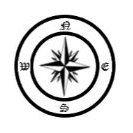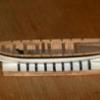HOLIDAY DONATION DRIVE - SUPPORT MSW - DO YOUR PART TO KEEP THIS GREAT FORUM GOING!
×
-
Posts
3,084 -
Joined
-
Last visited
Reputation Activity
-
 Jaager got a reaction from ERS Rich in How serious do you get about dust protection
Jaager got a reaction from ERS Rich in How serious do you get about dust protection
From the pictures, there seems to be a very important component missing:
The plus added to your vac system by having a passive cyclone dust separator inline
is difficult to over state. Very little reaches the body of the vac. I too have an Oneida
Dust Deputy. I got one on sale, but it is worth list.
An RCV switch - garage door type unit to turn on power to the vac - is very handy.
-
 Jaager got a reaction from Nearshore in Attaching channels?
Jaager got a reaction from Nearshore in Attaching channels?
Looking at Kevin's picture: I have always had a mistrust of being able to get the holes to exactly match up with the dowels. I just thought of a way to do it. Use a third piece of wood. One that is as wide as the channel is thick. Make it thick enough that a drill bit has to go in perpendicular. Site the dowel locations as holes in it. Use it as the gauge to drill the holes in the hull and in the channel.. I beg forgiveness of this is standard practice already. I just solves a long standing how-to-do-it for me.
-
 Jaager got a reaction from phebe in Philip Reed style Navy Board models: are there any on MSW?
Jaager got a reaction from phebe in Philip Reed style Navy Board models: are there any on MSW?
I have set for myself, rigid requirements for Navy Board framing:
It should not be used for a model of any ship built after 1719. The first seriously enforced Establishments seems to be the 1719.
Some here are disturbingly fast and loose about what is meant by Navy Board or even Admiralty.
Navy Board is the late 17th century stylized framing method. Franklin wrote the definitive book exploring Navy Board and its variations.
When it came out, the St. Philippe monograph blew my socks off. It is one of the few ships with reliable plans and is of the proper era.
As an aside, I think that Navy Board framing was developed to provide three proof diagonals for a proposed design. Proof diagonals that were 3D and easily understood by the royals in charge but who were unschooled in the art.
I did a series of station sandwich trials of various framing styles. It did it 1:120 for speed and material economy.
The all bends with a narrow space between - no way would I entertain the insane table joints at the midline of a bend - back on point - is too timber wall like.
The Navy Board framing revealed two serious penalties with this style. To get the solid belt at the turn of the bilge:
The floor - which is a formidable and expensive timber with conventional framing - becomes unreasonably large. For there to be the solid belts, each end must turn up like the horns of a longhorn bull. It is much longer and has two reverse curves. The waste is almost as bad as with the Hahn method but the stock must be significantly wider than is used with Hahn. I can't justify it.
Futtock 1 - although it is actually F1 and F3 - it goes from above the wale to well below the turn of the bilge. It is long - really long - and it defines an arc of near 90 degrees. It also needs wide stock and produces and lot of waste - close packing of patterns is difficult to do.
I developed a compromise that has the solid belt and looks like Navy Board at first glace. The difference is that the spaces are all in the F1 frame. The floor is its normal 60% of beam length. F2 butts against the floor. It is longer than a normal F2, but it starts at the turn of the bilge so the arc is much less. I place a piece of timber that overlaps (scarphs) the floor to F2 joint that is the width of the solid belt of Navy Board.
I named it Navall timber framing. The original navall timber was a free floating timber that started about halfway up the floor and overlapped the lower half of F2. It was between two floors but did not touch either one. Times passes and the navall timber evolves to be F1. In Navall timber framing as I have designed it, the timber is too long to be a chock but too short to be a futtock 1. Naming it a navall timber works for me even though it does bond to the floor on either side.
I have framed a 1:60 hull of HMS Centurion 1732 using Navall Timber Framing. I have the bow framed also. I am well into the stern framing, but it is really a bear to do. But right now, my Muse has been gone for a while. It is another of my hulls in frame on the stocks. But it is a successful proof of concept as far as the method is concerned.
There is one negative factor: the solid belt at the bilge and the solid wall above the wale is prone to humidity stress. Titebond II makes a strong bond, but in a few places, Mother Nature and expanding wood from internal water pressure has shown it self to be stronger than PVA.
As for true miniature scale, there are several here, bur none are Navy Board. To me, a miniature is as much if not more about Art and artistry than straight forward ship modeling using wood. I think 1/8th scale 1:96 is more than enough crazy making. Going for an even smaller scale requires a special courage and inspiration. It does have the advantage of being economical as far as the cost of the wood.
-
 Jaager got a reaction from Taygz in Looking for the Correct Sequence and Terminology for Deck Plank Butt Shift
Jaager got a reaction from Taygz in Looking for the Correct Sequence and Terminology for Deck Plank Butt Shift
The only way I can see that there can be 5 numbers in a four butt shift is if the four refers to the number of planks between two planks having their butt on the same beam. The repeating sequence actually involves five planks.
The first picture above, numbering from the top down = Beam 1 - beam 3 - beam 5 - beam 2 - beam 4
The second, top down = beam 1 - beam 4 - beam 2 - beam 3
The American "Lloyds" ASA 1870 " No butts of adjoining plank should be nearer each other than the space of two beams ( when a stake intervenes the distance of one beam will be allowed). No butts should meet on the same beam unless there be three stakes between them."
The second picture fails that rule.
-
 Jaager got a reaction from KeithAug in Thurston saw blades
Jaager got a reaction from KeithAug in Thurston saw blades
First - thank you for your visit here.
I think that a significant number of us use machines with:
ID 1/2"
OD 4" max
OD 3" when it is sufficient for the depth of cut
For our uses it would make things more clear if you provided a table for TPI
Assume that the material being cut is dense hardwood Maple or harder maximum depth is >1"
Max TPI per thickness of cut
We use expensive wood so we wish to minimize loss to kerf
So the table should also include minimum blade thickness per depth of cut to avoid blade flex.
What we go by now is from an old Hobby Mill publication:
"For sheet stock above 3/16" or 4.5mm: Use the I-293 .040 kerf blade.
Actually you can use this blade on thinner stock but it has a thicker kerf (more waste) and a few less teeth than the I-292 blade (chipout sooner with thinner stock)
For stock between 3/32" (3mm) - 3/16" (4.5mm): Use I-292 .030 kerf blade. If there is chipout around 3/32", go to the #99 blade
For stock between 3/64" (1mm) - 3/32" (3mm): Use #99 170T blade. Main change in blade is the finer pitch
For stock thinner than 3/64" (1mm): Use #100 224T blade."
These are probably the most often used blades.
If you have better experienced based suggestions there would probably be interest here.
For stock thinner than 3/64" (1mm): Use #100 224T blade.
-
 Jaager got a reaction from Zocane in Best paint for wooden ship models
Jaager got a reaction from Zocane in Best paint for wooden ship models
I believe back in the era when things were fast and loose - when diet pills contained live eggs from tapeworms - What? they worked!
- shellac thinner was methanol - wood alcohol. Now it is 95% ethanol - with an emetic additive to make it tax free.
Shellac has been listed as "cut". One pound cut is 1 lb of flakes per gallon of alcohol.
The amber version is saturated at 3-5 lb cut - I forget which. I just read that Zinsser premixed is 3lb.
The darker the color, the more wax. The wax increases the solubility in alcohol. I believe super blonde flakes saturate at about 1.5lb cut.
For a first coat - there is better penetration if the concentration is 50% saturated (1:1) alcohol to dissolved shellac.
Until shellac is something that you are comfortable with - it is easier to use the pre-mixed. Get a Qt. of shellac thinner too.
Amber if it is painted over or the natural wood wants "warming".
White if minimal effect on the existing color is desired.
For all practical purposes 95% ethanol is as water free as you can get.
Shellac thinner is less expensive.
Pharmco grain from the ABC store will work just as well (190 proof = 95%) if you want to support state and Fed governments by paying taxes you don't need to pay.
If you come across a deal that seems too good to be true, there is probably a higher water concentration.
I have been wondering if moonshine would work. I distilled ethanol long ago - the 95% comes out of the condenser as much smaller drops than water.
But I am thinking that moonshine has been diluted or distilled with less care? Doing the job that they do - already indicates that questionable ethics are in play -so dealing with a moonshiner is false economy.😉
Both, shellac and ethanol are natural products - brand is pretty much irrelevant.
"If you come across a deal that seems too good to be true, there is probably" something involved that you do not want.
For flakes - right now I like the 1/4 lb bags from Lee Valley. I am of the hope that the garnet flakes will have a pleasant effect on my Hard Maple - like adding 200 years to the look.
-
 Jaager got a reaction from miloman in Wood Glues
Jaager got a reaction from miloman in Wood Glues
I would place money on the compounds that polymerize - the vinyl and acrylic components - have one chemical company as their origin. It is probably a toxic and hazardous process not cost effective to replicate in multiple locations. The gemisch that is the commercial product probably has a few more manufacturers but not as many as there are products. Some are just rebranded. If two companies have products in the same shaped dispenser, they probably come off of the same line. A line that forks just before the labeling machines.
PVA when polymerized looks like intertwined fungal hyphae. The thinner the zone of just vinyl chains between two meeting surfaces, the stronger the bond. Clamping pressure = bond strength. The limiting factor is the amount of pressure the wood fibers can resist before they crush.
If a POB build has molds that are plywood, it would probably be prudent to prime the areas that are end grain with pushed in and surface wiped PVA. Let it cure and then bond the planking.
-
 Jaager got a reaction from miloman in Wood Glues
Jaager got a reaction from miloman in Wood Glues
I used Franklin pre-mixed Hide glue as a reversible glue. It holds too well the way I applied it.
I coated both surfaces. I used tolerances that were too exact.
Hide glue is a protein. Hot ethanol will denature it and have it curl into small balls. It would have been exactly what I want - if there was room for the hot ethanol to penetrate the glue joint.
Hide glue is probably what the pre- 20th century models were assembled with. If your goal is a 100-200 year lifespan it should serve.
The Franklin and Old Brown versions are convenient but the high percentage that is water is a worry.
The glue pot hot dissolved flakes has much less water and would probably be the wise option. Offering a wide choice of critter origins for relative strength.
It is however a witches brew process that takes addition time and skill before the actual wood joining step can begin. This lack of convenience is a difficult hurdle to justify when compared to just applying a bleb of Titebond II spreading it as a complete monolayer on both meeting surfaces.
About Duco - it probably helps to read the directions. Totally coat both meeting areas - let dry - apply a wet layer and get together really sorta fast. It does hold better.
-
 Jaager got a reaction from Old Collingwood in Best paint for wooden ship models
Jaager got a reaction from Old Collingwood in Best paint for wooden ship models
I believe back in the era when things were fast and loose - when diet pills contained live eggs from tapeworms - What? they worked!
- shellac thinner was methanol - wood alcohol. Now it is 95% ethanol - with an emetic additive to make it tax free.
Shellac has been listed as "cut". One pound cut is 1 lb of flakes per gallon of alcohol.
The amber version is saturated at 3-5 lb cut - I forget which. I just read that Zinsser premixed is 3lb.
The darker the color, the more wax. The wax increases the solubility in alcohol. I believe super blonde flakes saturate at about 1.5lb cut.
For a first coat - there is better penetration if the concentration is 50% saturated (1:1) alcohol to dissolved shellac.
Until shellac is something that you are comfortable with - it is easier to use the pre-mixed. Get a Qt. of shellac thinner too.
Amber if it is painted over or the natural wood wants "warming".
White if minimal effect on the existing color is desired.
For all practical purposes 95% ethanol is as water free as you can get.
Shellac thinner is less expensive.
Pharmco grain from the ABC store will work just as well (190 proof = 95%) if you want to support state and Fed governments by paying taxes you don't need to pay.
If you come across a deal that seems too good to be true, there is probably a higher water concentration.
I have been wondering if moonshine would work. I distilled ethanol long ago - the 95% comes out of the condenser as much smaller drops than water.
But I am thinking that moonshine has been diluted or distilled with less care? Doing the job that they do - already indicates that questionable ethics are in play -so dealing with a moonshiner is false economy.😉
Both, shellac and ethanol are natural products - brand is pretty much irrelevant.
"If you come across a deal that seems too good to be true, there is probably" something involved that you do not want.
For flakes - right now I like the 1/4 lb bags from Lee Valley. I am of the hope that the garnet flakes will have a pleasant effect on my Hard Maple - like adding 200 years to the look.
-
 Jaager got a reaction from Old Collingwood in Best paint for wooden ship models
Jaager got a reaction from Old Collingwood in Best paint for wooden ship models
Theory = full size paint does not need as fine a pigment grind and for reasons of cost probably does not. At miniature scales, a close look probably resembles a gravel road.
I am pretty sure that @Bob Cleek has been espousing the use of premier quality arts oils - both water based and organic solvent based - the stuff in tubes - as the whole of what is needed.
Infinite dilution, a flattening agent can be added, for oil base, polymerizing oils can be added, these also have a catalyst to speed polymerization. I would think that even the smallest tubes would last much longer than a mini-bottle of pre-mixed model paints.
Two solutions:
a primer coat of 1:1 diluted shellac followed by a full strength coat would provide an ideal base - plus mask any of Nature's glitches in the wood.
(Not sure about silicon from lubricant mis-spread being where it shouldn't = fish eye.)
After the final pre-sanding - paint the wood with water or water with 10-20% white PVA - then sand again. This gets the water caused swelling out of the way.
-
 Jaager got a reaction from billocrates in HMS ANSON 1781 by albert - 1/48 - 64 guns
Jaager got a reaction from billocrates in HMS ANSON 1781 by albert - 1/48 - 64 guns
HMS Anson 1781 second group of the Intrepid class 64 gun
1st class
Intrepid 1779 1771
Monmouth 1772 1778
Defiance 1772 1778
Nonsuch 1774 1776
Ruby 1776 1778
2nd class
Vigilant 1774
Eagle 1774 1776
America 1777 1778
Anson 1781
Polyphemus 1782
Magnanime 1780
Sampson 1781
Repulse 1780
Diadem 1782 1783
Standard 1782
This class is one of the more documented designs
ZAZ
1486 lines L37 J3635
1487 frames 45 3682
1488 inboard
1489 orlop
1490 GD
1491 UD
1409 orlop 34 3242
1410 GD 34 3241
1311 UD 34 3240
1412 QD/FC 32 3239
If no print has ever been ordered and is not in stock: no price
The NMM wed site has the J# but does not identify them.
-
 Jaager got a reaction from Saburo in HMS ANSON 1781 by albert - 1/48 - 64 guns
Jaager got a reaction from Saburo in HMS ANSON 1781 by albert - 1/48 - 64 guns
HMS Anson 1781 second group of the Intrepid class 64 gun
1st class
Intrepid 1779 1771
Monmouth 1772 1778
Defiance 1772 1778
Nonsuch 1774 1776
Ruby 1776 1778
2nd class
Vigilant 1774
Eagle 1774 1776
America 1777 1778
Anson 1781
Polyphemus 1782
Magnanime 1780
Sampson 1781
Repulse 1780
Diadem 1782 1783
Standard 1782
This class is one of the more documented designs
ZAZ
1486 lines L37 J3635
1487 frames 45 3682
1488 inboard
1489 orlop
1490 GD
1491 UD
1409 orlop 34 3242
1410 GD 34 3241
1311 UD 34 3240
1412 QD/FC 32 3239
If no print has ever been ordered and is not in stock: no price
The NMM wed site has the J# but does not identify them.
-
 Jaager got a reaction from GrandpaPhil in solid hull vs. plank on bulkhead/frame
Jaager got a reaction from GrandpaPhil in solid hull vs. plank on bulkhead/frame
Look up Dana Weger in the back issue CD's of the NRJ. I believe that hollowing out the layers is actually a requirement for acquisition by a USN museum.
I view it as rather than "can" the situation during the planning stage is more "I need to have a really good reason not to hollow every layer but the bottom one."
@Bob Cleek Champions at version of bread and butter that I had missed: Do the left and right sides as two pieces that meet at the midline.
If I did not have an incurable case of POF disease, I think that I would have to do it this way.
The pattern would be for one side. Bond the port side layer to (on top of) the stb side using something easily reversible - shellac, rubber cement, Duco, ....
This is a two for one scroll cut process.
Bandsaw the outer lines - outside and inside - then debond - add the mirror pattern to the port side piece and do the rough bevel.
At the core plan to pattern stage I would add alignment sites for pins or Bamboo skewer dowels - so that port side pattern has something other than the outside shape to site it.
These dowels can also be used to match layer 1 to layer 2, layer 2 to layer3, etc. in an idiot proof way.
It is also probably good to have lines at and perpendicular to the midline at glue site. Using a jig for hole depth, dowels can be used to position port to stb and enforce the glue bond.
2nd question. Where would I get plans and/or cast parts for a WW1 warship?
For reasons of sanity, I have limited myself to 1660-1860 wood and sail (obviously this is still too broad) so I can only speculate.
Besides what I think is a lively steel group that hangs somewhere else - for USN I would look to the NA. For the RN, the NMM probably has more than you could ever want,
For other European navies and Japan - you probably can find locals who would know.
The AAMM has
LE CHARLEMAGNE - first class battleship (1894-1920)
Scale of drawing : 1/200th
Le Hoche
Battleship (1886 -1913)
Taubman plans list at Loylhanna Dockyard looks like a possible source.
A WWI warship's topsides are a lot busier and more interesting than the WWII generation, but the pre- Dreadnought / Great White Fleet steel vessels can be really interesting.
-
 Jaager got a reaction from thibaultron in The Shellback's Library A cautionary tale or a search for a productive contact for this vendor
Jaager got a reaction from thibaultron in The Shellback's Library A cautionary tale or a search for a productive contact for this vendor
I can across this site doing a search for an out of print book
The Shellback's Library
There are over 1,300 reprint nautical publications here. Chart your course thru our site.
We are a small reprint publishing house established in 1998. We offer thousands of books and publications.
Our products are one of three types; bound books, bookleted boat plans or data sheets. Unlike many vendors, we have carefully researched our nautical products and so we can provide a description, often with pictures, of each craft or subject.
contact D.N.Goodchild phone number is southeast corner of Pennsylvania
Lots of interesting titles - but one filled a hole in by library
I figured that it was worth a $40 risk for a 1670 book with the sizes of spars and rigging.
I ordered the book - paid using PatPal - the money was deducted from my account. No further communication from the vendor. No email, no book.
I initiated an inquiry thru PayPal and after time and hoop jumping - but no response from the vendor - I received a full refund today.
The book:
Hardcover Elephant Folio
THE BOATSWAIN'S ART, or THE COMPLETE BOATSWAIN
by >Henry Bond, Teacher of Navigation, Surveying, and other parts of the Mathematicks, near Ratcliff-Cross. The Scale is made in Brass or Wood by Joseph Hone on Tower-Wharf.
Wherin is shewed a true Proportion for the Masting, Yarding,a nd Rigging of any Ship, whose Length, Breadth, and Depth is known: with Rules for the Sizes and Lengths of all sorts of Rigging that belongs to any Ship. Also the use of an opening Scale, that if the length of the Main Mast be put upon it with a pair of Compasses, you may measure upon the Scale the Lengths and Thickness of all the other Masts and Yards; and also the Sizes, the Lengths and the number of Fathoms of every Size for the Rigging of any Ship, without altering the Scale. Also here is added a Plain and Easie Rule for Rigging andy Ship by the Length of its own Masts and Yards. London, Printed by W. Godbid, for William Fisher at the Postern-Gate near Tower-Hill, and Benjamin Hurlock over against St. Magnus-Church on London-Bridge near Thmes-Street. 1670
So goes the title page for this substantive and influential early work on ship-building, rigging and management, originally published in1670. Our reprint retains the type style and form of the original and is completely reset in that style, with the exception of the extender "s'ses", e.g., (from above) "Wherein is fhewed a true Proportion for the Mafting, Yarding, and Rigging of any Ship, whofe . . . etc." All other seventeenth century attributes and spelling are retained however. An example of the original title page and that of our reprint is shown below. Included in the compilation are "A Plain and Easie Rule" (1676) as mentioned above and also "The Sizes and Lengths of Rigging for all His Majesties Ships and Frigats." (1660)
Henry Bond, Wm. Fisher & Edward Hayward, 105 pages
SOME OTHER TITLES OF varying relivance
Square Rig
MARINE ... Diderot's Maritime Volume from the great Encyclopedia of he an d'Alembert. (Fifteenth and Sixteenth Century)
Dideriot and D'Alembert, 100 pages, Pub No. 0052
MASTING; MASTMAKING; AND RIGGING OF SHIPS ... also Tables of Spars, Rigging, Blocks, Chain, Wire and Hemp Ropes, etc., relative to every class of vessel.
Robert Kipping, 236 pages, Pub No. 0054
SEAMAN'S FRIEND, THE ... A Treatise on Practical Seamanship; A Dictionary of Sea Terms; Customs and Usages of the Merchant Service; and Laws.
Richard Henry Dana, 275 pages, Pub No. 0055
STEEL'S ELEMENTS OF MAST-MAKING; SAIL-MAKING . . ... A "must-have" text for the serious modeler and anyone with a ship-of-the-line or a frigate.
Claude S. Gill, 300 pages, Pub No. 0056
YOUNG SEA OFFICER'S SHEET ANCHOR, THE ... The first real seaman's manual.
d Arcy Lever, 255 pages, Pub No. 0057
KEDGE ANCHOR OR YOUNG SAILOR'S ASSISTANT, THE ... Appertaining to the Practical Evolutions of Modern Seamanship, Rigging, Knotting, Splicing, Blocs, Purchases, Running-Rigging
William Brady, 400 pages, Pub No. 0096
OLD WOODEN WALLS, THE ... Their construction, equipment, etc. Being an abridged edition of the Falconer's celebrated Marine Dictionary.
Claude S. Gill, 202 pages, Pub No. 0282
BOATSWAIN'S ART, OR COMPLETE BOATSWAIN, THE ... Rigging ships in 1670 -" the masting, yarding and rigging of any ship whose length, breadth and depth is known."
Henry Bond, Wm. Fisher & Edward Hayward, 105 pages, Pub No. 0284
COMPLETE SHIPWRIGHT, THE ... "Plainly & demonstratively teaching the proportions used by experienced shipwrights according to their custom of building."
Edmund Bushnell, 76 pages, Pub No. 0285
NOSE AGAINST THE GLASS IS FRUSTRATING!
Are we dealing with another Norwegian Blue Parrot here?
-
 Jaager got a reaction from catopower in Cool Little Block Plane
Jaager got a reaction from catopower in Cool Little Block Plane
I have in mind the concept that spars were not exactly a straight line taper. Is it not a curve with a slope that increases - with most of the increase in the outer quarter? A very shallow ellipse?
Now that I visualize it. A jig with parallel sides and a shim that slides under the spar. The shim would allow for an elliptical profile.
I think the process would be significantly faster than a lathe. Planing along the grain would mimic the action of an adz and not leave a surface that is a series of concentric rings - which is what a lathe does.
-
 Jaager got a reaction from thibaultron in Schooner plank length
Jaager got a reaction from thibaultron in Schooner plank length
The ASA rules up to 1903 call for both deck planks and hull planks to be "the greatest length possible".
I suspect that by the turn of the 20th century, a significant portion of the old growth timber had been felled in eastern North America..
The mid 19th century US Navy wanted deck planks to be 40 feet long. The favored species was (I think) Yellow Pine. It is not a wood that is seen much today - maybe some is recycled - everything usable was harvested - it is a species that is rock hard, it liked to turn a nail - not at all a soft Softwood. I think that some has been replanted, but without consulting my Silviculture references, I suspect a species that hard and tall would be fairly slow growing. As desirable as it would be, I suspect that a southern tree farmer would have to plant Yellow Pine for his grandchildren or great grandchildren to harvest. I sort of doubt that Georgia Pacific would be up for doing it.
So I think it would come down to what was available, as to length. Your guess would be as good as mine, on what it would be. It was probably even more restricted in Northern and Western Europe. My shipyard will use planks 25-40 feet long. But for an individual ship, a single length, instead of random. If a particular strake would need a short piece at either end, the intent is to cheat and use a longer board instead of having a stub. It is important to follow the butt stagger rules. After seeing so much of the opposite here, the goal is to have the butts not so obvious to avoid the busy look. The deck is not supposed to be a star. My yard inspectors mentally register the words: tacky, boring, naive, distracting, inauthentic on viewing a job done like that. It is also to wonder about the logic behind having obvious and contrasting trunnels just at the butts and not also at every beam.? In any case, trunnels should not be a contrasting shade.
-
 Jaager got a reaction from Pitan in wax or no wax?
Jaager got a reaction from Pitan in wax or no wax?
The choices
Linen seems to be lost into the past.
Cotton - limited lifespan - smaller fibers -smaller fuzz
Poly - seems to be winning the race. As long as the model itself is plastic, any resistance to using man-made materials is moot.
Poly already is what a wax would provide. Wax seems to me to be pointless. If it is beeswax on it - I would question it ever case hardening to become NOT a dust magnet.
Paraffin would change its phase with changes in room temp. The semi liquid phase would also hold dust.
Renaissance wax will case harden as its organic solvent evaporates. It is probably more positive than negative for linen and cotton. It would offer no advantage with poly.
-
 Jaager got a reaction from Canute in What Wax To Use On Rigging Line
Jaager got a reaction from Canute in What Wax To Use On Rigging Line
It drys to a hard shell. It is used to protect steel tables and tools from humidity produced rusting. So it will not be a sticky dust magnet. It also does not contain trace amounts of insect digestive enzymes or anything to allow hydrogen ions for to be acidic.
Plastic polymer line IS a shell. There is nothing about it that needs a wax coating of any kind.
-
 Jaager got a reaction from thibaultron in What Wax To Use On Rigging Line
Jaager got a reaction from thibaultron in What Wax To Use On Rigging Line
It drys to a hard shell. It is used to protect steel tables and tools from humidity produced rusting. So it will not be a sticky dust magnet. It also does not contain trace amounts of insect digestive enzymes or anything to allow hydrogen ions for to be acidic.
Plastic polymer line IS a shell. There is nothing about it that needs a wax coating of any kind.
-
 Jaager got a reaction from IronShips in Free CAD program
Jaager got a reaction from IronShips in Free CAD program
A NURBS modeler is better for precise and predefined curves. For animation in a vertex based program - a NURBS model that is then converted to polys can be way too "heavy" to allow render times within a human's lifespan. Is there a free NURBS based program?
-
 Jaager got a reaction from MCan in Ultimation tools
Jaager got a reaction from MCan in Ultimation tools
Might this tool help with getting a uniform thickness?
https://bridgecitytools.com/products/hp-8-mini-block-plane
-
 Jaager got a reaction from hamilton in bolting frames onto keel
Jaager got a reaction from hamilton in bolting frames onto keel
From the above, I would bolt the keelson to every timber. With a bolt already in every other timber a pattern that avoids having the keelson bolts and existing timber bolts on different tracks is needed. A "Z" with the hole 4" in from the edge of the keelson and since the floors are sided 11" ( 11/3= 3 2/3") about 3.5" in from the edge of the floor. The next timber would be a mirror. The floor bolts having the same pattern - staggered by one timber - but since it not visible, the floor to keel bolts can be skipped.
-
 Jaager got a reaction from mtaylor in bolting frames onto keel
Jaager got a reaction from mtaylor in bolting frames onto keel
From the above, I would bolt the keelson to every timber. With a bolt already in every other timber a pattern that avoids having the keelson bolts and existing timber bolts on different tracks is needed. A "Z" with the hole 4" in from the edge of the keelson and since the floors are sided 11" ( 11/3= 3 2/3") about 3.5" in from the edge of the floor. The next timber would be a mirror. The floor bolts having the same pattern - staggered by one timber - but since it not visible, the floor to keel bolts can be skipped.
-
 Jaager got a reaction from allanyed in bolting frames onto keel
Jaager got a reaction from allanyed in bolting frames onto keel
1. You do not make it easy when not identifying the class and year of Echo.
2. If you are at all serious about 18th C. RN vessels and aim at authenticity you should own a copy of Yedlinsky.
18 gun sloop of war:
Floor timber : Every other floor timber to be bolted through the main keel - bolt dia. = 1"
Keelson : To be square = 12" x 12"
exclusive of what is let down between the floors which may be = 7/8"
Scarphs in length = 4' 6"
The keelson bolts should be driven through and carefully clenched on the underside of the main keel dia. = 1"
Excepting where the rabbet for the plank is taken out in the middle. There, they come through and clench on the underside of the keel that is coaked to the main keel.
-
 Jaager got a reaction from hamilton in bolting frames onto keel
Jaager got a reaction from hamilton in bolting frames onto keel
1. You do not make it easy when not identifying the class and year of Echo.
2. If you are at all serious about 18th C. RN vessels and aim at authenticity you should own a copy of Yedlinsky.
18 gun sloop of war:
Floor timber : Every other floor timber to be bolted through the main keel - bolt dia. = 1"
Keelson : To be square = 12" x 12"
exclusive of what is let down between the floors which may be = 7/8"
Scarphs in length = 4' 6"
The keelson bolts should be driven through and carefully clenched on the underside of the main keel dia. = 1"
Excepting where the rabbet for the plank is taken out in the middle. There, they come through and clench on the underside of the keel that is coaked to the main keel.















